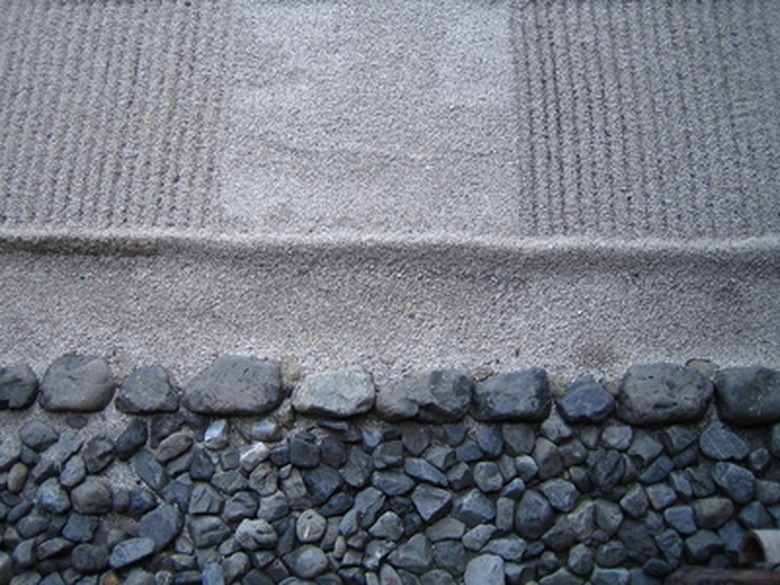Facts Of Zen Gardens
Practiced since A.D. 900, Japanese gardening is meant to bring calmness and focus to a landscape. Designed around six aesthetic principles that harness the beauty and power of nature, Zen gardens are meant to help those who wander through them forget the hectic world outside.
Origins
Zen spread throughout Japan with the rise of the samurai warrior class. As the new religion spread, so did temples and gardens dedicated to it.
Purpose
The purpose of a Zen garden is to help quiet and focus your mind. Ponds in a Zen garden, for example, represent negative space, or the "nothingness" that is essential to Zen meditation. In addition, the sound of dripping water is meant to remind you to exist in the moment with each drip.
- Practiced since A.D. 900, Japanese gardening is meant to bring calmness and focus to a landscape.
- Designed around six aesthetic principles that harness the beauty and power of nature, Zen gardens are meant to help those who wander through them forget the hectic world outside.
Principles
Zen gardens are designed around six aesthetic principles. Theses principles are: fukinsei, or asymmetry; kanso, or simplicity; koko, or venerability; yugen, or subtlety and mystery; datsoku, or otherworldliness; and seijanku, or stillness.
Elements
Stones, water, plants, bridges, and ornaments are essential elements of Zen gardens. Each element has symbolic meaning. Pine trees, for example, represent strength and patience, as enlightenment can only be gained by one who possesses these qualities. Placing a frog figurine in the garden represents sudden realization, symbolized by a frog jumping into a quiet pond.
Zen in Miniature
Today, faced with limited space and resources, some people create miniature Japanese gardens. Some are small enough to fit on a desktop, while others are built as part of a room or even a rooftop.
- Zen gardens are designed around six aesthetic principles.
- Stones, water, plants, bridges, and ornaments are essential elements of Zen gardens.
Zen Garden?
The style of Japanese garden most often referred to as a Zen garden originated around the first third of the 14th century, at the end of the Kamakura period and the beginning of the Muromachi period. During this time the growing influence of Zen Buddhism and its emphasis on contemplation led to a change in garden design characterized by an increased use of stone, a focus on the definition of space within the garden and an increased awareness of how visitors experienced gardens. The typical Zen garden is a dry landscape, with very few plants and no water included in the garden design. Man-made elements include bridges, lanterns, and an enclosing perimeter wall or fence. In a traditional Zen garden, the man-made elements are made from wood or stone rather than metal to emphasize the garden's connection to the natural world. Sand represents water, and stones of various shapes represent various aspects of nature; flat stones represent the earth, for example, and arching stones represent fire.
- The style of Japanese garden most often referred to as a Zen garden originated around the first third of the 14th century, at the end of the Kamakura period and the beginning of the Muromachi period.
- In a traditional Zen garden, the man-made elements are made from wood or stone rather than metal to emphasize the garden's connection to the natural world.
Zen Garden?
The style of Japanese garden most often referred to as a Zen garden originated around the first third of the 14th century, at the end of the Kamakura period and the beginning of the Muromachi period. During this time the growing influence of Zen Buddhism and its emphasis on contemplation led to a change in garden design characterized by an increased use of stone, a focus on the definition of space within the garden and an increased awareness of how visitors experienced gardens. The typical Zen garden is a dry landscape, with very few plants and no water included in the garden design. Man-made elements include bridges, lanterns, and an enclosing perimeter wall or fence. In a traditional Zen garden, the man-made elements are made from wood or stone rather than metal to emphasize the garden's connection to the natural world. Sand represents water, and stones of various shapes represent various aspects of nature; flat stones represent the earth, for example, and arching stones represent fire.
- The style of Japanese garden most often referred to as a Zen garden originated around the first third of the 14th century, at the end of the Kamakura period and the beginning of the Muromachi period.
- In a traditional Zen garden, the man-made elements are made from wood or stone rather than metal to emphasize the garden's connection to the natural world.
References
- Helpful Gardener: Zen and Its Influence on the Japanese Garden
- Stanford Journal of East Asian Affairs: The Japanese Garden for the Mind: The 'Bliss' of Paradise Transcended
- Bowdoin College: The Japanese Garden
- San Jose State University: Historical Japanese Gardens
- Stanford Journal of East Asian Affairs: The Japanese Garden for the Mind: The 'Bliss' of Paradise Transcended
- Bowdoin College: The Japanese Garden
- San Jose State University: Historical Japanese Gardens
